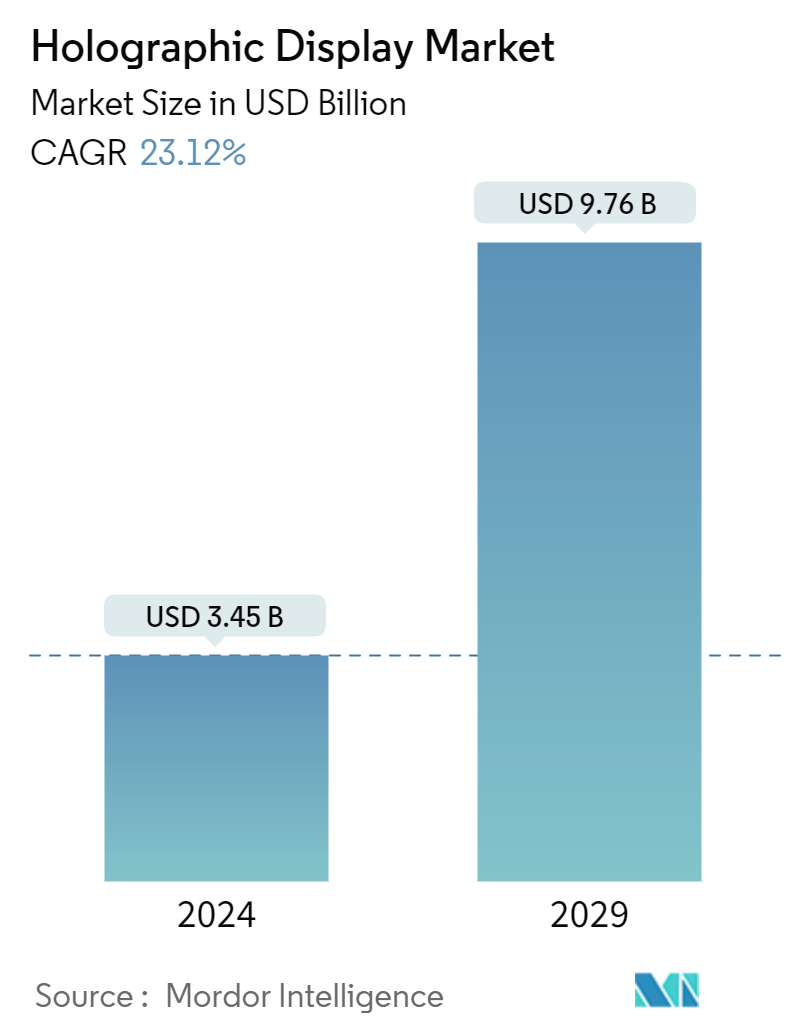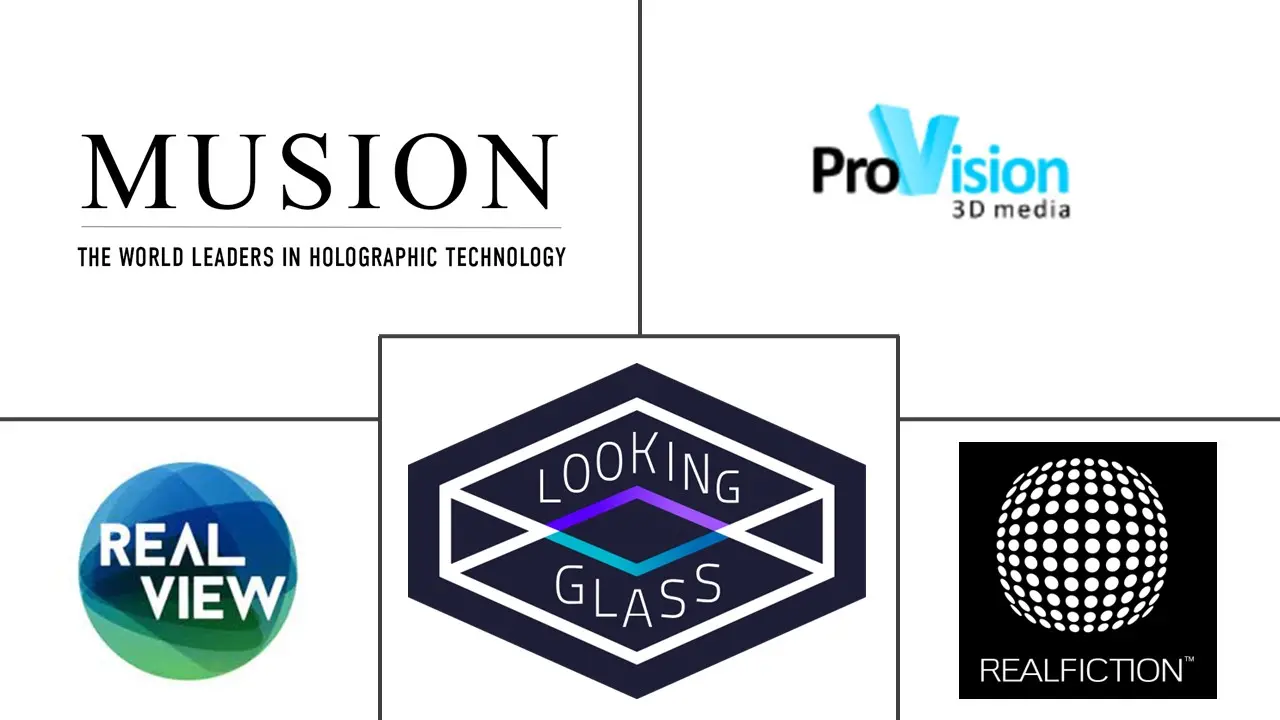Market Size of Holographic Display Industry

| Study Period | 2019 - 2029 |
| Market Size (2024) | USD 3.45 Billion |
| Market Size (2029) | USD 9.76 Billion |
| CAGR (2024 - 2029) | 23.12 % |
| Fastest Growing Market | Asia Pacific |
| Largest Market | North America |
| Market Concentration | Medium |
Major Players
*Disclaimer: Major Players sorted in no particular order |
Holographic Display Market Analysis
The Holographic Display Market size is estimated at USD 3.45 billion in 2024, and is expected to reach USD 9.76 billion by 2029, growing at a CAGR of 23.12% during the forecast period (2024-2029).
- Holograms are being used in the industry, mainly in the developing field of proximity marketing, which enables businesses to interact and grow their clientele by positioning themselves to engage clients more individually.
- The holographic display market may witness a sharp increase over the next few years, especially in developed nations such as the US, with help from various industry players to augment the regional demand subject to the extensive product applications in automotive, healthcare research, and medical imaging.
- While the need for holographic displays is driven by the healthcare, automotive, and media industries, applications in media and entertainment, education, residential (living rooms), and military mapping are anticipated to catalyze the market under study.
- Holographic displays are also employed in billboards, kiosks, point-of-sale terminals, digital signs, venues, and events. The popularity of holographic displays in all of these uses may fuel market expansion. For instance, digital signage solutions have been widely used in the retail industry, with big and emerging firms choosing advanced digital signage with AI and machine learning to maximize the potential of consumer data.
- Technology improvements have had a significant impact on the innovative solutions that are currently being offered in the market. With the use of 3D holographic displays, it is now feasible to develop a visual brand experience that makes use of neuromarketing. In any crowded location, whether in a store, at an expo, or in public areas, the seemingly free-floating holograms can naturally make people stop and pay attention.
- However, the prohibitive cost of manufacturing holographic display devices limits market expansion. New technologies must be created and manufactured as part of the process, which could be expensive for smaller businesses. Additionally, consumers in developing countries might find the prices prohibitive, restricting the market's expansion there.
Holographic Display Industry Segmentation
A holographic display reflects digital material through glass coated with a specific coating, known as glass optics, using a high-definition or 4K screen. When positioned at a specific angle, the glass optic will produce an optical illusion that causes the consumer's brain to see the digital information as three-dimensional.
The holographic display market is segmented by end-user (consumer electronics, retail, media and entertainment, military and defense, healthcare, automotive, and other end-user verticals) and geography (North America, Europe, Asia Pacific, and Rest of the world). The market sizes and forecasts are provided in terms of value (USD) for all the above segments.
| By End-user Verticals | |
| Consumer Electronics | |
| Retail | |
| Media and Entertainment | |
| Military and Defense | |
| Healthcare | |
| Automotive | |
| Other End-user Verticals |
| By Geography*** | |
| North America | |
| Europe | |
| Asia | |
| Australia and New Zealand | |
| Latin America | |
| Middle East and Africa |
Holographic Display Market Size Summary
The holographic display market is poised for significant growth, driven by advancements in technology and increasing applications across various industries. Holograms are becoming integral in proximity marketing, allowing businesses to engage customers more personally. The market is expected to expand rapidly, particularly in developed regions like the United States, due to the diverse applications in sectors such as automotive, healthcare, and media. The use of holographic displays in digital signage, billboards, and events is gaining traction, with companies leveraging AI and machine learning to enhance consumer engagement. Despite the high manufacturing costs posing challenges, the market is witnessing innovations that promise to enhance brand experiences through 3D holographic displays.
In the automotive sector, holographic technology is emerging as a key player, with applications in head-up displays and dashboard interfaces. The industry is seeing a shift from high-end to mid-range vehicles adopting this technology, driven by its versatility and low power consumption. The Asia-Pacific region, particularly China, Japan, and South Korea, is a significant market due to its advanced consumer electronics and automotive industries. The region's growth is supported by rising demand for digital signage and head-up displays. The market is semi-consolidated, with major players focusing on technological advancements and strategic partnerships to enhance their market share. Recent developments include the introduction of innovative holographic displays by companies like Realfiction Holding AB and ARHT Media, further propelling the market's expansion.
Holographic Display Market Size - Table of Contents
-
1. MARKET INSIGHTS
-
1.1 Market Overview
-
1.2 Industry Attractiveness - Porter's Five Forces Analysis
-
1.2.1 Bargaining Power of Suppliers
-
1.2.2 Bargaining Power of Consumers
-
1.2.3 Threat of New Entrants
-
1.2.4 Threat of Substitutes
-
1.2.5 Intensity of Competitive Rivalry
-
-
1.3 Industry Value Chain Analysis
-
1.4 Assessment of Impact of COVID-19 on the Industry
-
1.5 Technology Snapshot
-
1.5.1 Touchable Holographic
-
1.5.2 Semi-transparent/Electro Holographic
-
1.5.3 Pistons Holographic
-
1.5.4 Laser/Plasma Holographic
-
-
-
2. MARKET SEGMENTATION
-
2.1 By End-user Verticals
-
2.1.1 Consumer Electronics
-
2.1.2 Retail
-
2.1.3 Media and Entertainment
-
2.1.4 Military and Defense
-
2.1.5 Healthcare
-
2.1.6 Automotive
-
2.1.7 Other End-user Verticals
-
-
2.2 By Geography***
-
2.2.1 North America
-
2.2.2 Europe
-
2.2.3 Asia
-
2.2.4 Australia and New Zealand
-
2.2.5 Latin America
-
2.2.6 Middle East and Africa
-
-
Holographic Display Market Size FAQs
How big is the Holographic Display Market?
The Holographic Display Market size is expected to reach USD 3.45 billion in 2024 and grow at a CAGR of 23.12% to reach USD 9.76 billion by 2029.
What is the current Holographic Display Market size?
In 2024, the Holographic Display Market size is expected to reach USD 3.45 billion.

